The document discusses inheritance in Java, explaining its role in object-oriented programming, including definitions of superclass and subclass, types of inheritance (single, multilevel, hierarchical), and the concept of code reusability. It covers method overriding, the use of the 'super' keyword, and the distinction between method overriding and overloading, as well as the use of the 'final' and 'static' keywords. Finally, it introduces abstract classes and methods, highlighting their significance in abstract data representation.
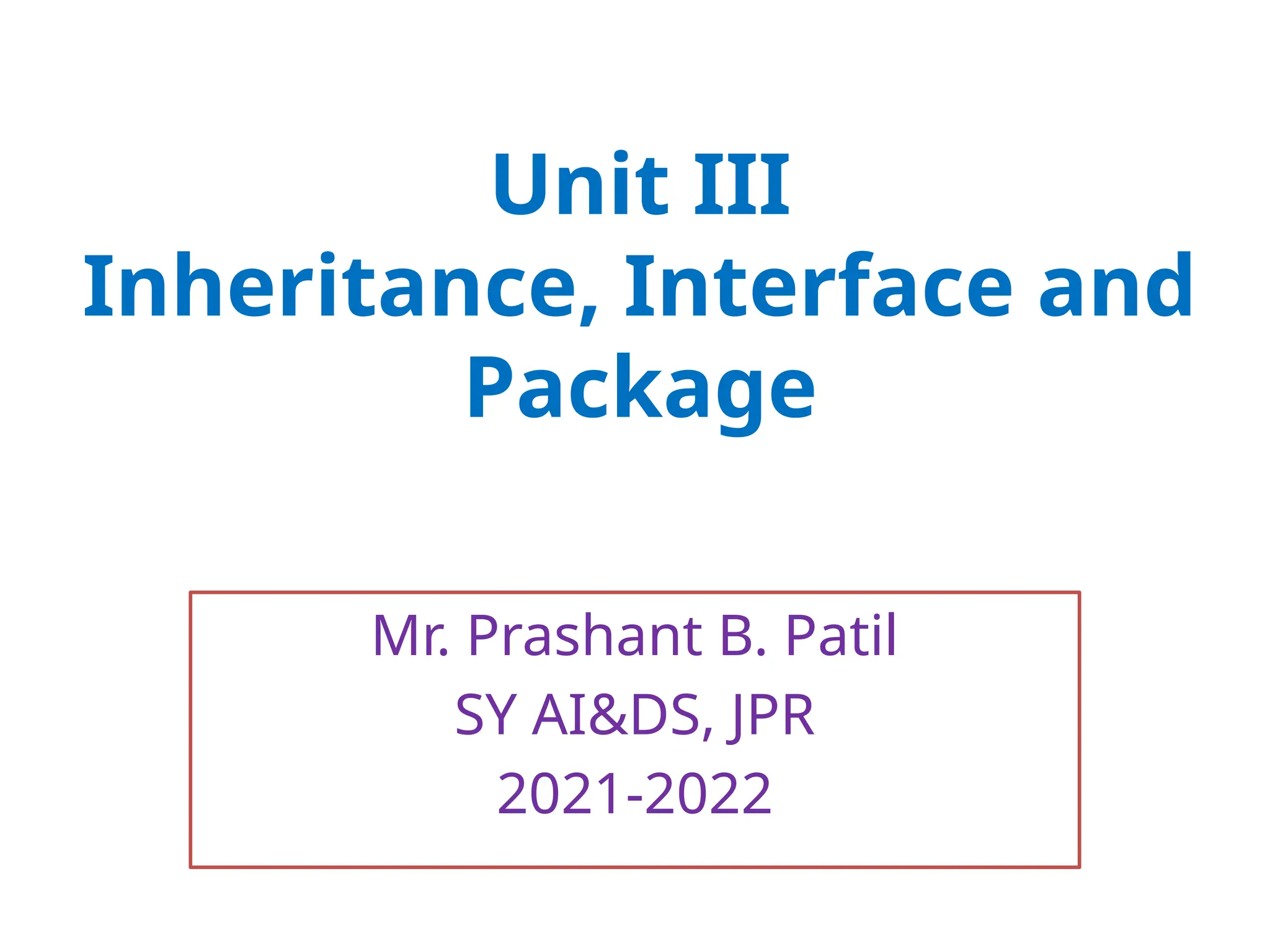
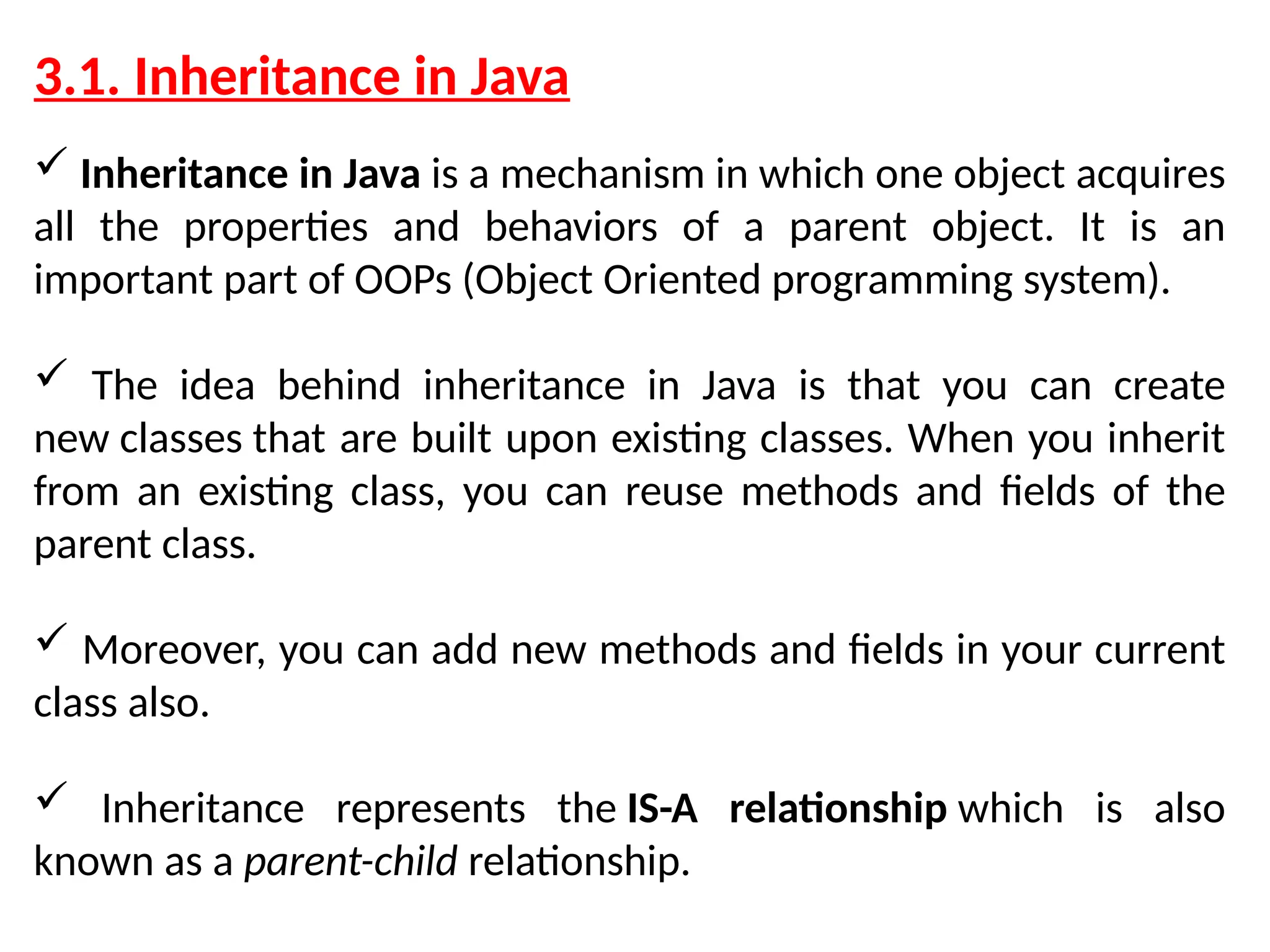
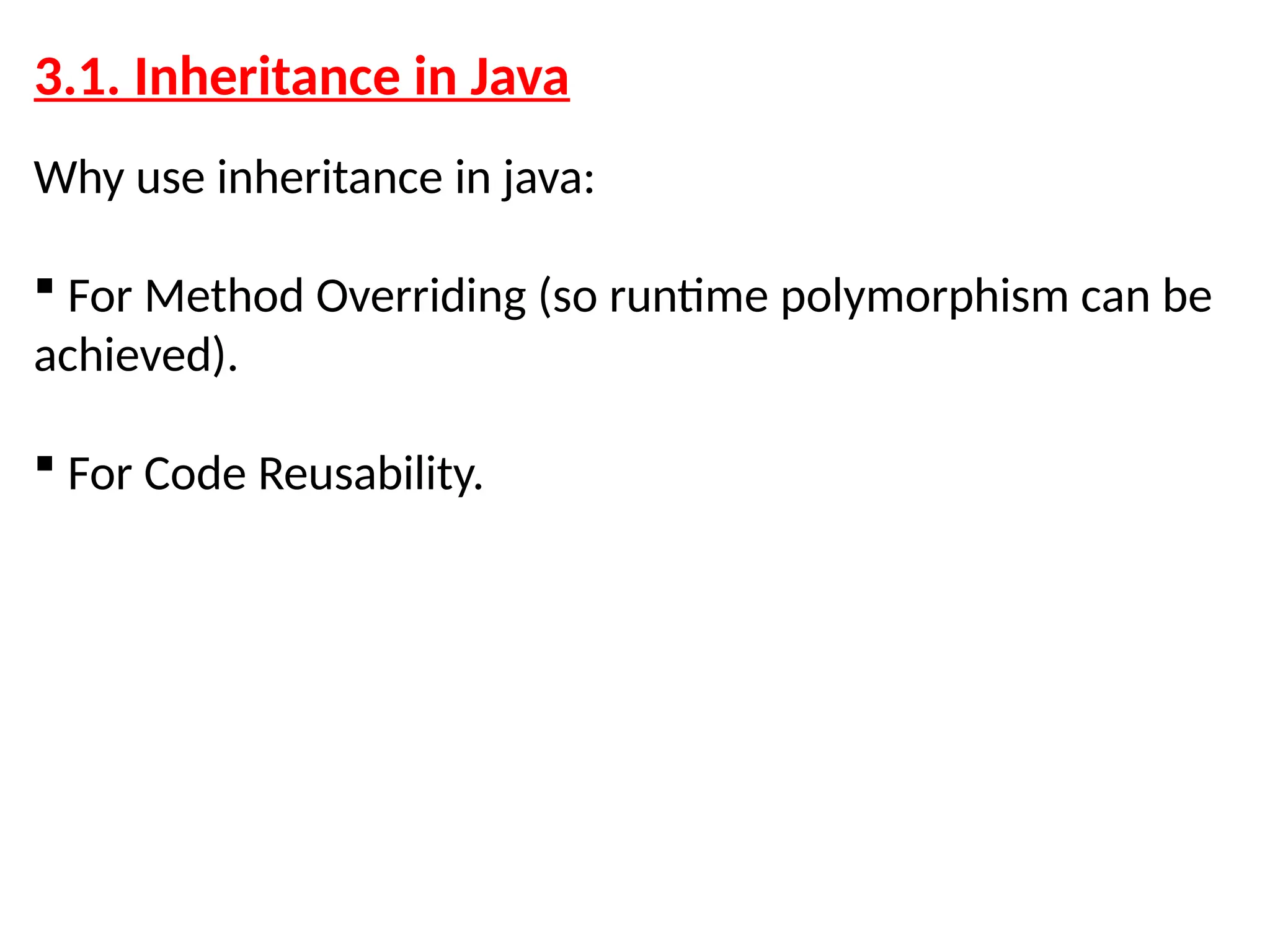
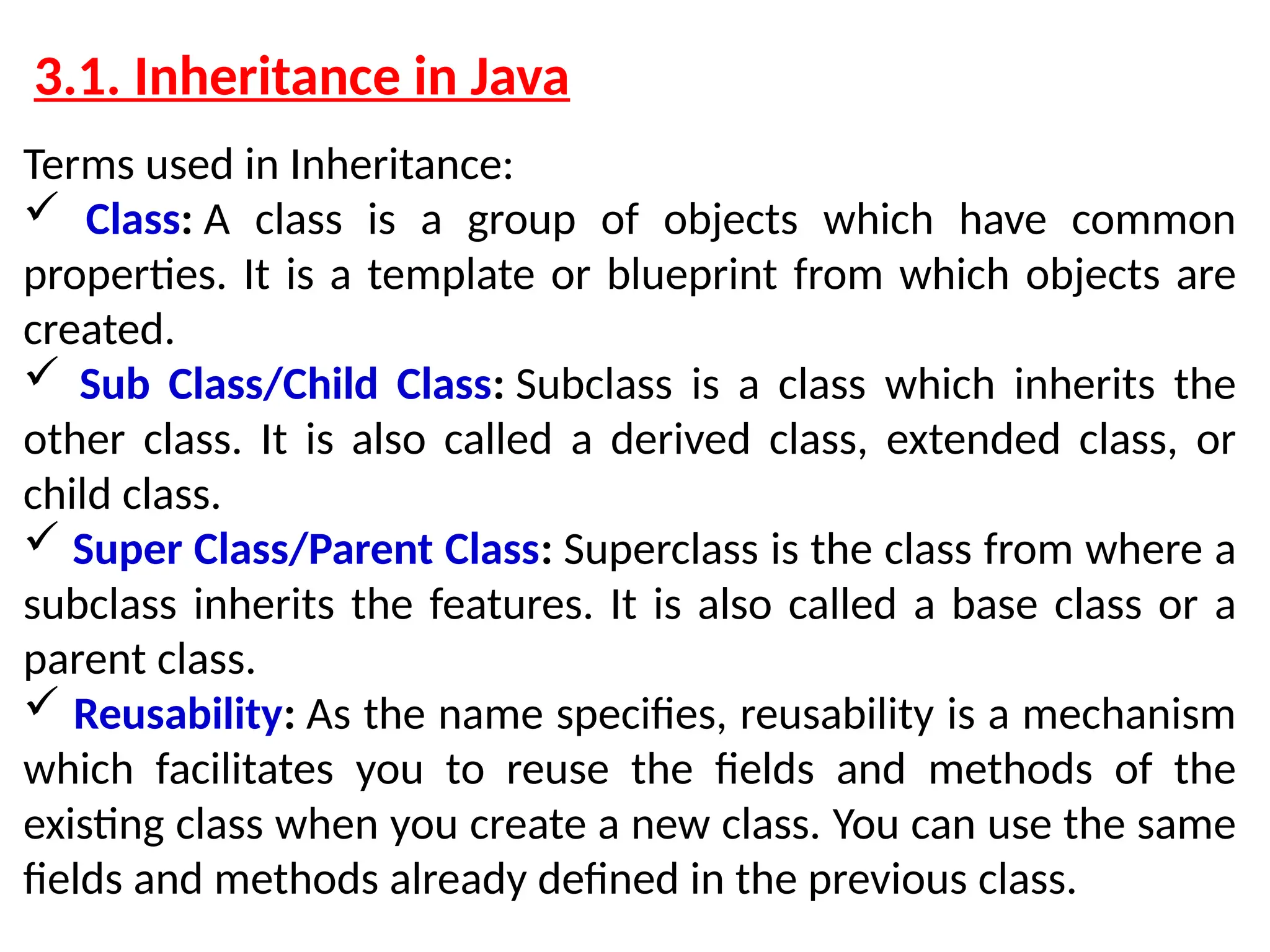
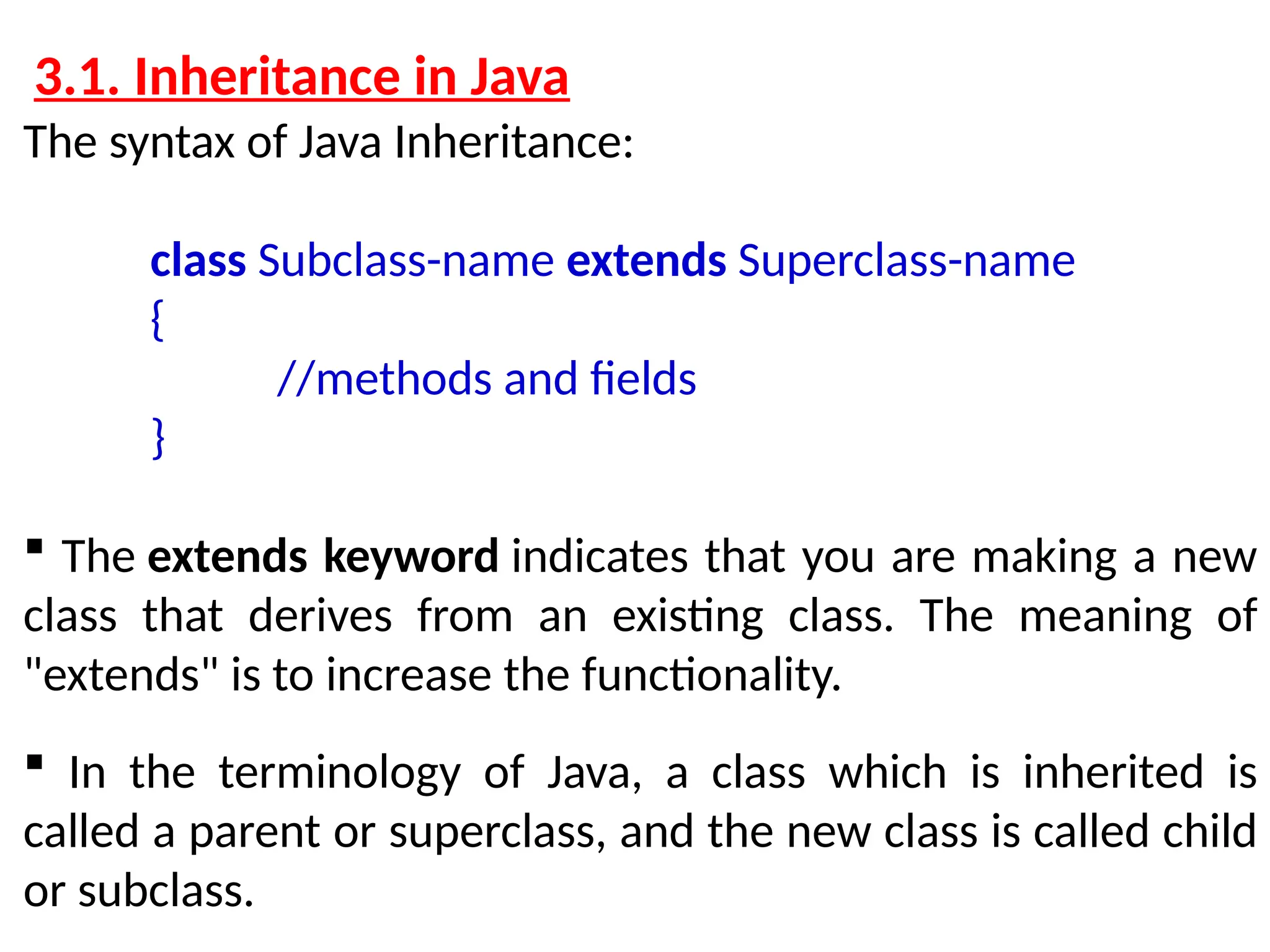
![3.1. Inheritance in Java Java Inheritance Example: class Employee { float salary=40000; } class Programmer extends Employee { int bonus=10000; public static void main(String args[]) { Programmer p=new Programmer(); System.out.println("Programmer salary is:"+p.salary); System.out.println("Bonus of Programmer is:"+p.bonus); } }](https://image.slidesharecdn.com/chapter3-250130083842-f888bdcc/75/Inheritance-Interface-and-Packags-in-java-programming-pptx-6-2048.jpg)

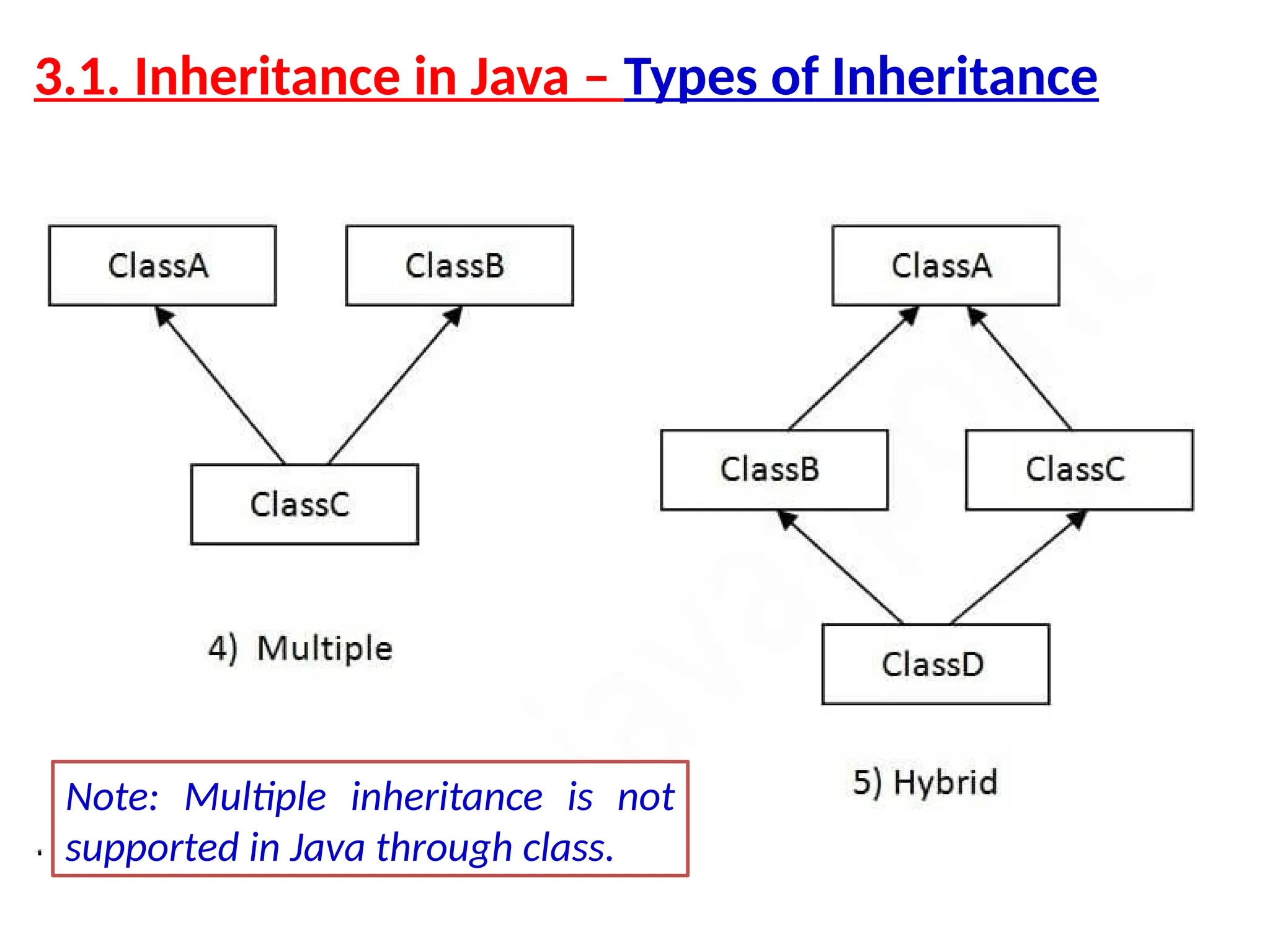

![3.2. Inheritance in Java – 1. Single Inheritance In the example given below, Dog class inherits the Animal class, so there is the single inheritance. class Animal { void eat() { System.out.println("eating..."); } } class Dog extends Animal { void bark() { System.out.println("barking..."); } } class TestInheritance { public static void main(String args[]) { Dog d=new Dog(); d.bark(); d.eat(); } }](https://image.slidesharecdn.com/chapter3-250130083842-f888bdcc/75/Inheritance-Interface-and-Packags-in-java-programming-pptx-10-2048.jpg)

![ As you can see in the example given below, BabyDog class inherits the Dog class which again inherits the Animal class, so there is a multilevel inheritance. class Animal { void eat() { System.out.println("eating..."); } } class Dog extends Animal { void bark() { System.out.println("barking..."); } } class BabyDog extends Dog { void weep() { System.out.println("weeping..."); } } class TestInheritance2 { public static void main(String args[]) { BabyDog d=new BabyDog(); d.weep(); d.bark(); d.eat(); } } 3.2. Inheritance in Java – 2. Multilevel Inheritance](https://image.slidesharecdn.com/chapter3-250130083842-f888bdcc/75/Inheritance-Interface-and-Packags-in-java-programming-pptx-12-2048.jpg)
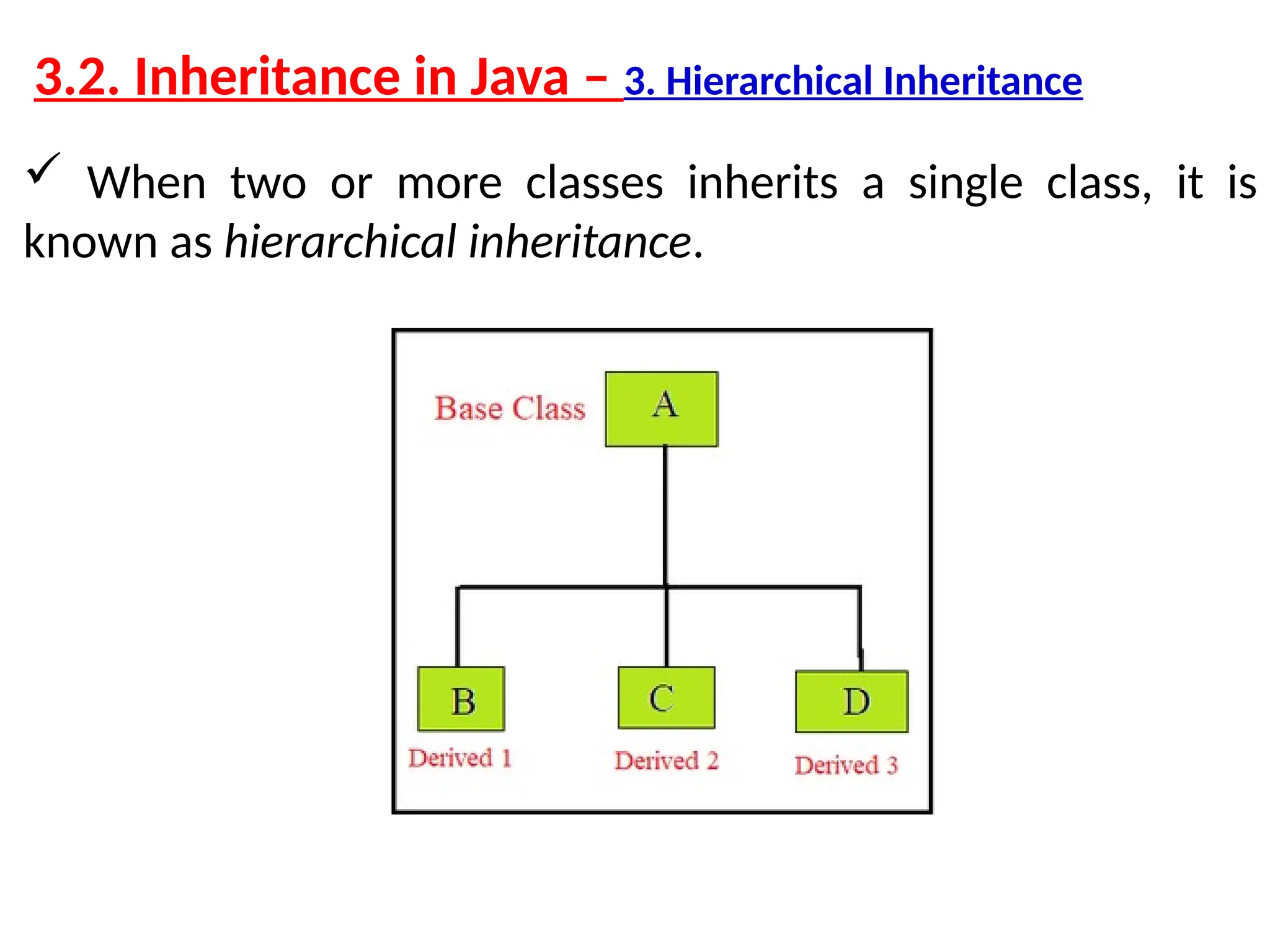
![3.2. Inheritance in Java – 3. Hierarchical Inheritance In the example given below, Dog and Cat classes inherits the Animal class, so there is hierarchical inheritance. class Animal { void eat() { System.out.println("eating..."); } } class Dog extends Animal { void bark() { System.out.println("barking..."); } } class Cat extends Animal { void meow() { System.out.println("meowing..."); } } class TestInheritance3 { public static void main(String args[]) { Cat c=new Cat(); c.meow(); c.eat(); Dog d=new Dog(); d.bark(); //c.bark(); //C.T.Error } }](https://image.slidesharecdn.com/chapter3-250130083842-f888bdcc/75/Inheritance-Interface-and-Packags-in-java-programming-pptx-14-2048.jpg)
![3.2. Why multiple inheritance is not supported in java? To reduce the complexity and simplify the language, multiple inheritance is not supported in java. Consider a scenario where A, B, and C are three classes. The C class inherits A and B classes. If A and B classes have the same method and you call it from child class object, there will be ambiguity to call the method of A or B class. class A { void msg() { System.out.println("Hello"); } } class C extends A,B { public static void main(String args[]) { C obj=new C(); obj.msg(); //Now which msg() method would be invoked? } } class B { void msg() { System.out.println("Welcome"); } }](https://image.slidesharecdn.com/chapter3-250130083842-f888bdcc/75/Inheritance-Interface-and-Packags-in-java-programming-pptx-15-2048.jpg)

![class base { int a; base (int z) { a=z; System.out.println(a); } } 3.2. Parameterized Constructor in Base Class Class derived extends base { int b; derived (int x, int y) { super(x); b = y; System.out.println(b); } } class test { public static void main(String args[]) { derived d = new derived(10,20); } } Calls base constructor Calls only derived constructor](https://image.slidesharecdn.com/chapter3-250130083842-f888bdcc/75/Inheritance-Interface-and-Packags-in-java-programming-pptx-17-2048.jpg)
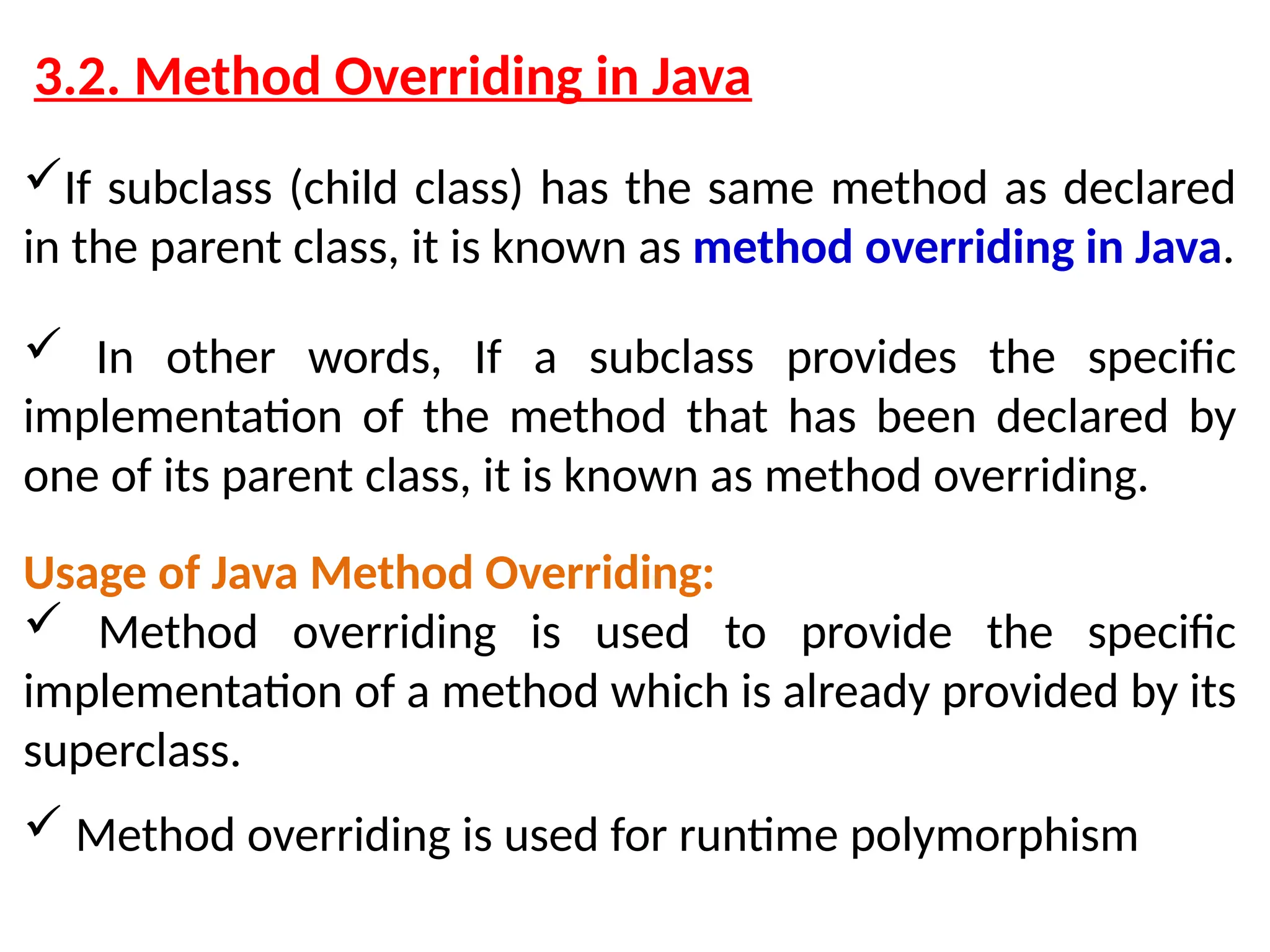

![3.2. Method Overriding in Java class base { void display () { System.out.println(“Base Class”); } } Class derived extends base { void display() { super.display(); System.out.println(“Derived Class”); } } class test { public static void main(String args[]) { derived d = new derived(); d.display(); } } Calls to base method Calls derived method](https://image.slidesharecdn.com/chapter3-250130083842-f888bdcc/75/Inheritance-Interface-and-Packags-in-java-programming-pptx-20-2048.jpg)
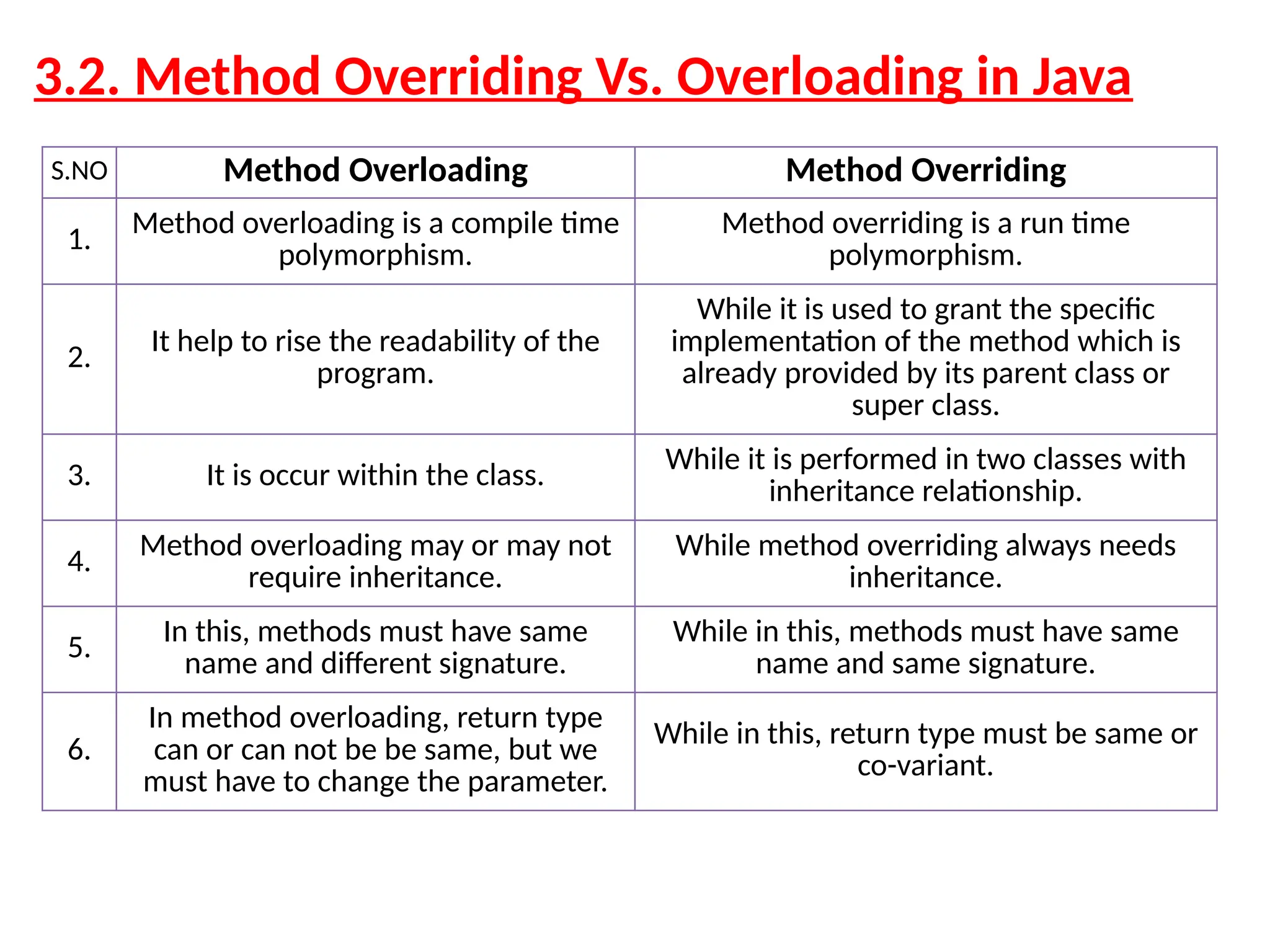
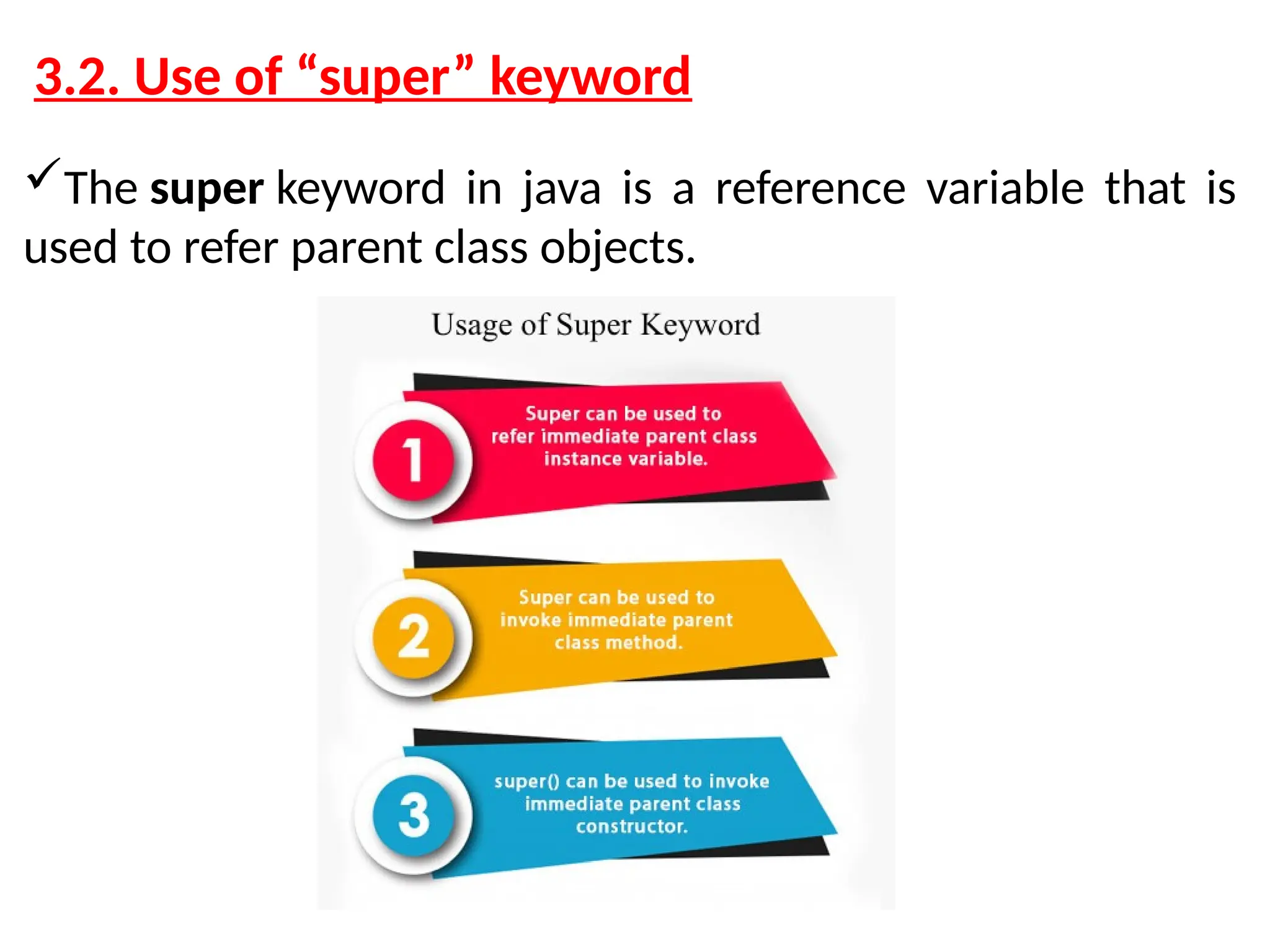
![class base { int a; } Class derived extends base { int a; void display() { a=10; super.a=20; System.out.println(“a”); System.out.println(“super.a”); } } class test { public static void main(String args[]) { derived d = new derived(); d.display(); } } Calls to base class member 3.2. Use of “super” keyword](https://image.slidesharecdn.com/chapter3-250130083842-f888bdcc/75/Inheritance-Interface-and-Packags-in-java-programming-pptx-23-2048.jpg)
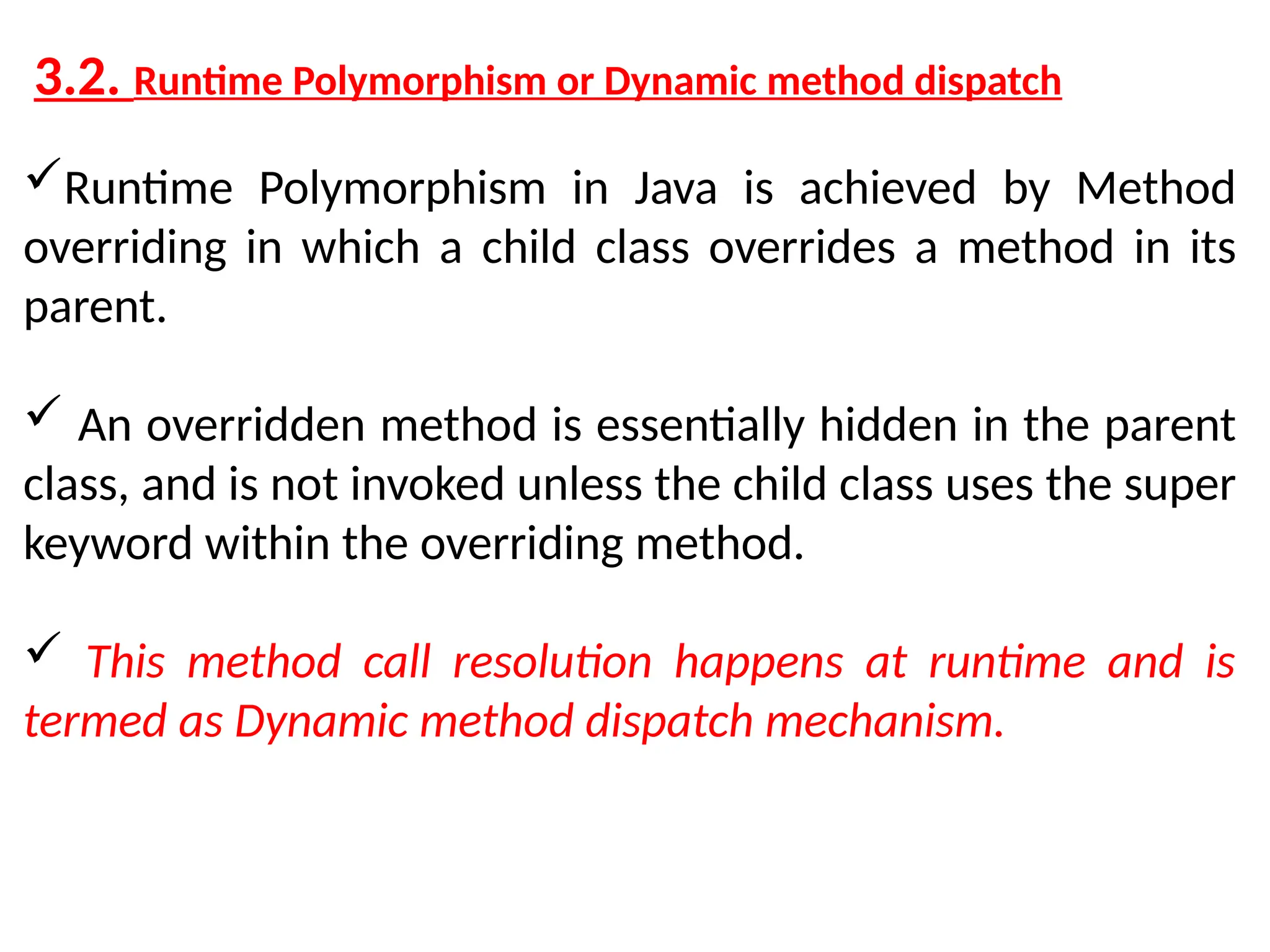
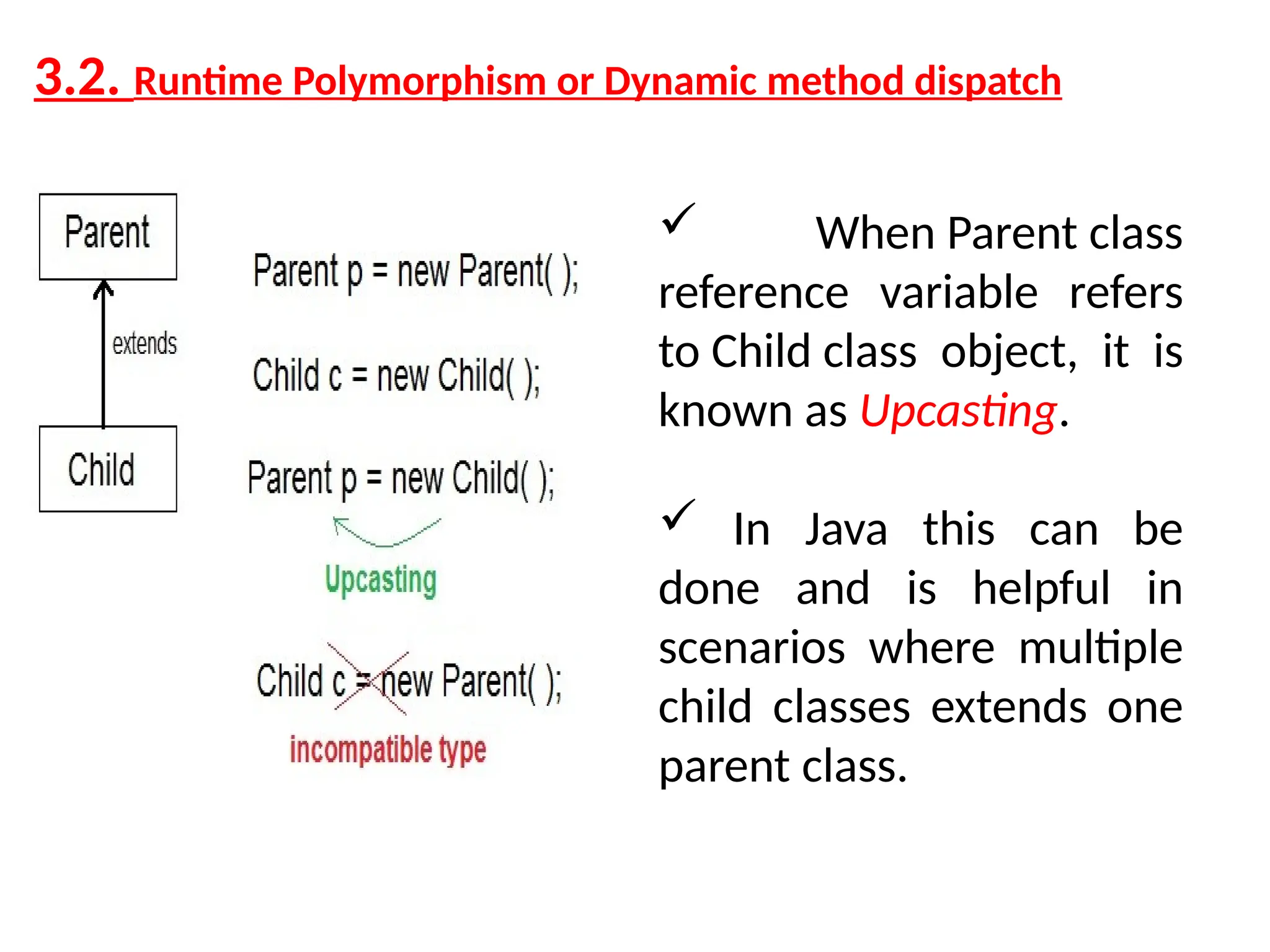

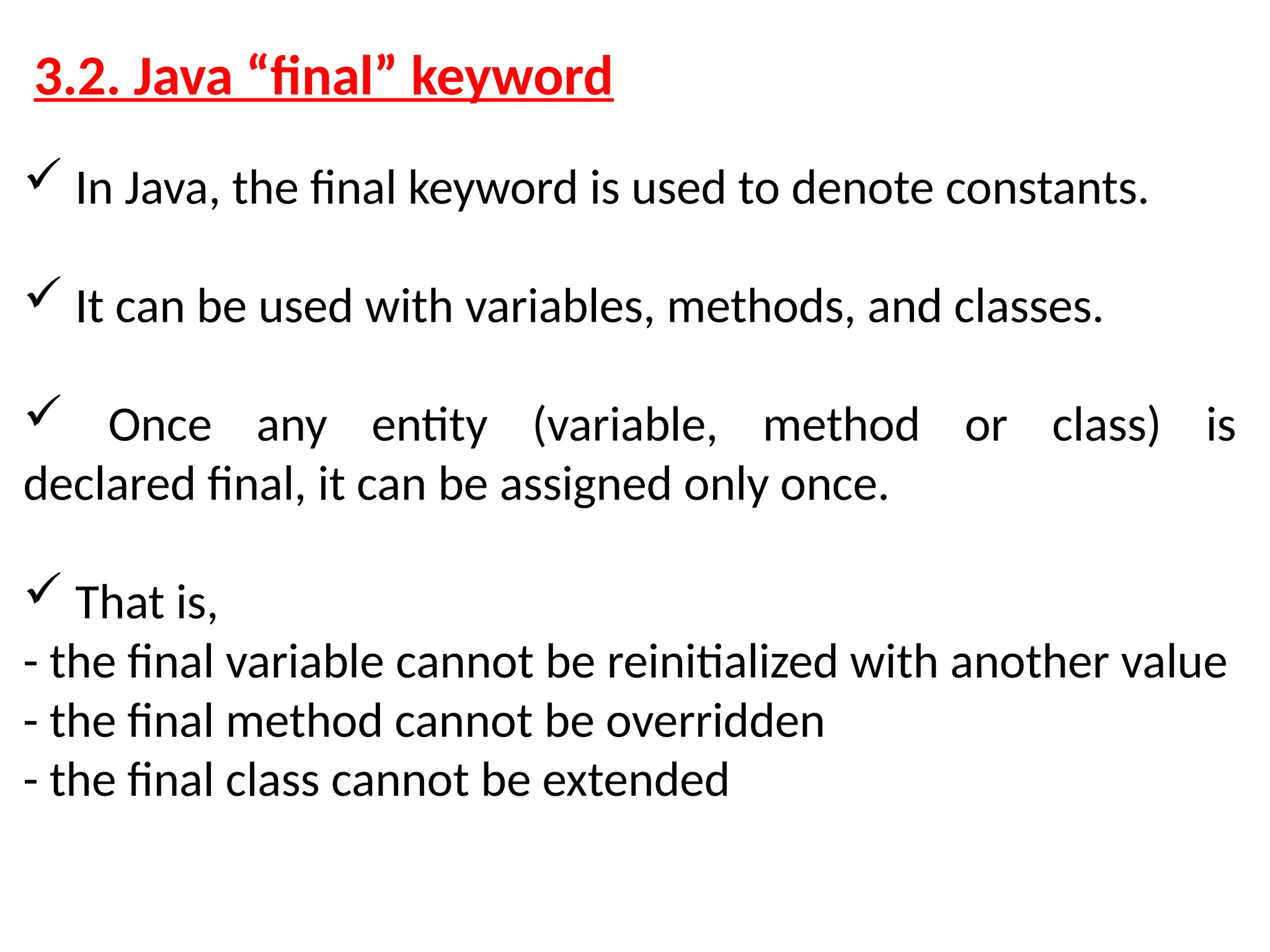
![3.2. Java “final” keyword 1. Java final Variable In Java, we cannot change the value of a final variable. For example: class test { public static void main(String[] args) { final int AGE = 32; AGE = 45; //Error System.out.println("Age: " + AGE); } } Error cannot assign a value to final variable AGE AGE = 45; ^](https://image.slidesharecdn.com/chapter3-250130083842-f888bdcc/75/Inheritance-Interface-and-Packags-in-java-programming-pptx-28-2048.jpg)
![3.2. Java “final” keyword 2. Java final Method: In Java, the final method cannot be overridden by the child class. For example, class FinalDemo { public final void display() { System.out.println("This is a final method."); } } class test extends FinalDemo { public final void display() { System.out.println("The final method is overridden."); } public static void main(String[] args) { test obj = new test(); obj.display(); } } Error display() in Main cannot override display() in FinalDemo public final void display() { ^ overridden method is final](https://image.slidesharecdn.com/chapter3-250130083842-f888bdcc/75/Inheritance-Interface-and-Packags-in-java-programming-pptx-29-2048.jpg)
![3.2. Java “final” keyword 3. Java final Class: In Java, the final class cannot be inherited by another class. For example, final class FinalClass { public void display() { System.out.println("This is a final method."); } } class test extends FinalClass { public void display() { System.out.println("The final method is overridden."); } public static void main(String[] args) { test obj = new test(); obj.display(); } } Error cannot inherit from final FinalClass class Main extends FinalClass {](https://image.slidesharecdn.com/chapter3-250130083842-f888bdcc/75/Inheritance-Interface-and-Packags-in-java-programming-pptx-30-2048.jpg)


![abstract class Bike { abstract void run(); } class Honda4 extends Bike { void run() { System.out.println("running safely"); } public static void main(String args[]) { Honda4 obj = new Honda4(); obj.run(); } } 3.2. Abstract Methods and Classes](https://image.slidesharecdn.com/chapter3-250130083842-f888bdcc/75/Inheritance-Interface-and-Packags-in-java-programming-pptx-33-2048.jpg)
![3.2. Java “static” keyword Static keyword can be used with class, variable, method and block. Static members belong to the class instead of a specific instance, this means if you make a member static, you can access it without object. The static can be: Variable (also known as a class variable) [Ex:static int a;] Method (also known as a class method) Block Nested class](https://image.slidesharecdn.com/chapter3-250130083842-f888bdcc/75/Inheritance-Interface-and-Packags-in-java-programming-pptx-34-2048.jpg)
![3.2. Java “static” keyword class SimpleStaticExample { static void myMethod() { System.out.println("myMethod"); } public static void main(String[] args) { /* You can see that we are calling this * method without creating any object. */ myMethod(); } } Static Method](https://image.slidesharecdn.com/chapter3-250130083842-f888bdcc/75/Inheritance-Interface-and-Packags-in-java-programming-pptx-35-2048.jpg)
![3.2. Java “static” keyword class JavaExample { static int num; static String mystr; static { num = 97; mystr = "Static keyword in Java"; } public static void main(String args[]) { System.out.println("Value of num: "+num); System.out.println("Value of mystr: "+mystr); } } Static Variables & Block](https://image.slidesharecdn.com/chapter3-250130083842-f888bdcc/75/Inheritance-Interface-and-Packags-in-java-programming-pptx-36-2048.jpg)